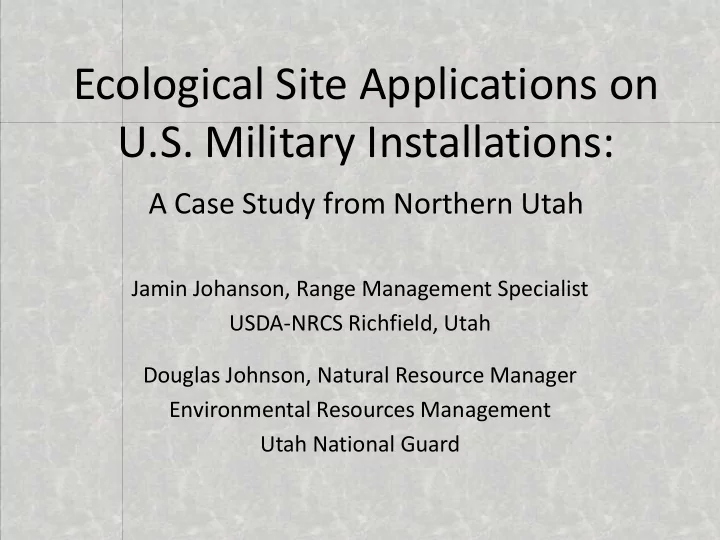

Ecological Site Applications on U.S. Military Installations: A Case Study from Northern Utah Jamin Johanson, Range Management Specialist USDA-NRCS Richfield, Utah Douglas Johnson, Natural Resource Manager Environmental Resources Management Utah National Guard
Military Training Facilities • There are hundreds of training facilities • Thousands of acres of range and forest land
Military Training Facilities • There are hundreds of training facilities • Thousands of acres of range and forest land Camp Williams *13 ecological sites on Camp Williams alone
Environmental Security Mandate The military is required to: – Comply with environmental laws – Protect training resources – Conserve natural resources
Environmental Security Mandate The military is required to: – Comply with environmental laws – Protect training resources – Conserve natural resources The military is also required to: – Train troops on the ground – Maneuver heavy equipment – Fire live ammunition, etc
Military Training Impacts
Integrated Training Area Management (ITAM) — Objectives • Determine the capacity of the land to sustain training and testing. • Sustain natural and cultural resources conditions by changing type, frequency, duration, or intensity of use, or by applying adjusted levels of repair and maintenance. • Monitor land and natural resources conditions and determine trends in those conditions. • Identify the risks and costs associated with exceeding the capacity of the land. • Establish a defined land condition baseline for natural and cultural resources that will be maintained through ITAM and is relevant to the installation environmental setting and mission activity.
Ecological Sites and ITAM • There is potential to meet the ITAM objectives using ESDs and STMs. • There is potential for ESDs to be improved with monitoring data collected through ITAM.
ITAM Data for ESD Development • LCTA data • RTLA data – 1990’s—2000’s – 2000’s— Today – 100 m Line-point – Project specific methods – Photographs – Photographs – Visited each year – Duration of project • Potential for identifying states • Little potential to use this data for ESD • Could be re-visited for development transitions • Contact individual bases for data availability
ITAM Data for ESD Development • LCTA data • RTLA data – 1990’s—2000’s – 2000’s— Today – 100 m Line-point – Project specific methods – Photographs – Photographs – Visited each year – Duration of project • Potential for identifying states • Little potential to use this data for ESD • Could be re-visited for development transitions • Contact individual bases for Useful, but discontinued data availability
ITAM Data for ESD Development • LCTA data • RTLA data – 1990’s—2000’s – 2000’s— Today – 100 m Line-point – Project specific methods – Photographs – Photographs – Visited each year – Duration of project • Potential for identifying states • Little potential to use this data for ESD • Could be re-visited for development transitions • Contact individual bases for data availability Current, but hard to use
Camp Williams – Military Training Facility Management Concerns – Localized training sites – foot traffic – Wildfires – Tracked vehicle use – Noxious weeds www.ut.ngb.army.mil/envir on/Natural_Resources.htm Photo by Sean Hammond
Camp Williams – Requested Research Camp Williams asked for: 1) Updated descriptions of 12 ecological sites 2) STMs for selected ecological sites
Partners • Camp Williams – Utah National Guard • Utah State University – Wildland Resources Department and Soils Lab • Natural Resources Conservation Service (NRCS) • Agricultural Research Service – Forage and Range Research Lab
ESD for Training Site Assessment • Use STM for site assessment • Guide Land Rehabilitation And Maintenance: reseeding or other restoration • Add military uses specific to installation to Ecological Site Interpretations.
STMs can fit the Green, Amber, and Red assessment commonly used in military reporting.
STMs can fit the Green, Amber, and Red assessment commonly used in military reporting.
STMs can fit the Green, Amber, and Red assessment commonly used in military reporting.
Environmental Management Uses • Use ESDs as basis for Vegetation Community Planning Level Survey (DODI 4715.03) • Use ESDs as basis for vegetation community/ecosystem management within Integrated Natural Resource Management Plans (Sikes Act)
Other Uses • Use Rangeland Health Assessments for ecosystem assessments that are “comparable to outside the fence.” • LCTA plots can be revisited; • 100-m point line transect can be re-sampled for comparison of vegetation over time • the Health Assessment supplements information for ecosystem management.
Where do we go from here? • As of right now: – Not all military installations are receptive/aware – There is no holistic way to access the ITAM data • Contact your local military base – Environmental Management Specialist
Questions?
Recommend
More recommend